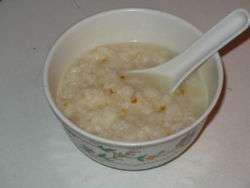Jiuniang
|
A bowl of guihua jiuniang (桂花酒酿) | |
| Type | Rice pudding |
|---|---|
| Place of origin | China |
| Main ingredients | Glutinous rice, fermentation starter (yeast and Aspergillus oryzae) |
|
| |
| Jiuniang | |||||||||||||||
| Traditional Chinese | 酒酿 | ||||||||||||||
|---|---|---|---|---|---|---|---|---|---|---|---|---|---|---|---|
| Hanyu Pinyin | jiǔniàng | ||||||||||||||
| |||||||||||||||
Jiuniang (酒酿, also called láozāo, 醪糟, or jiāngmǐjiǔ, 江米酒,tiánbáijiǔ,甜白酒 in Yunnan) is a sweet, soup- or pudding-like dish in Chinese cuisine. It consists of a mixture of partially digested rice grains floating in a sweet saccharified liquid, with small amounts of alcohol (1.5-2%) and lactic acid (0.5%). It is made by fermenting glutinous rice with a starter called Jiuqu (酒藥) containing Rhizopus oryzae and/or Aspergillus oryzae and often yeast and bacteria.
.jpg)
It was first developed as a by-product of mijiu production and generally speaking is partially digested and fermented rice from a young rice wine (or vinegar) ferment. If eaten quickly or held at 10 degrees or less which halts the fermentation, the product can be consumed as Jiuniang. If the temperatures are raised and fermentation continues, Jiuniang will eventually produce rice wine or rice vinegar. Jiuniang is most commonly made and consumed in the winter, where fermentation can be halted easily.[1]
Often Jiuniang is translated to Rice Sauce or even Rice Wine (due to its alcohol content) by western Chinese retailers. It is often made with Sweet Osmanthus flowers and the dish is called guihua jiuniang (桂花酒酿).
Jiuniang is often served together with small unfilled tangyuan during the Dongzhi Festival, a Chinese winter holiday dedicated to the ancestors. When served in such a manner it is called jiuniang tangyuan (酒酿汤圆) or "jiuniang yuanzi" (酒酿圆子) ,or white wine soup bubble baijiu tangyuan (白酒汤圆) in Yunnan, or, with Sweet Osmanthus, guihua jiuniang tangyuan (桂花酒酿汤圆) .All forms of jiuniang are typically eaten with a spoon.
It is very similar to the southern Vietnamese dish cơm rượu, which usually contains balls of rice. It is also similar to the Korean sikhye and Japanese amazake, although these are a bit thinner in texture and considered drinks rather than soups or puddings.
See also
- Rice pudding
- Mijiu
- Tapai
- List of Chinese desserts
- List of Chinese soups
- List of desserts
-
 Food portal
Food portal
References
- ↑ Li, Jian-rong, and Yun-Hwa P. Hsieh. "Traditional Chinese food technology and cuisine." Asia Pacific journal of clinical nutrition 13.2 (2004).
2. History of the later Han * Volume 32: 《后汉书。樊传》:“又野王岁献甘醪膏饧。”李贤注:“醪,醇酒汁滓相将也。”引伸为浊酒。
